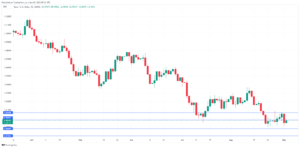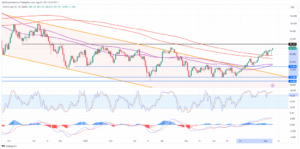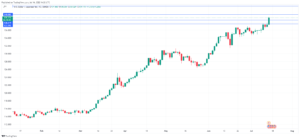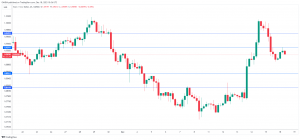US dollar in choppy waters
Currency markets had another choppy overnight session, which ultimately ended up sideways again, despite US inflation unexpectedly rising. EUR/USD traded to parity but managed to finish higher at 1.0040, a pattern repeated across most major currencies. With the US dollar looking overbought on short-term indicators as well, I suspect that the odds of a US dollar correction lower have risen sharply, especially as Asian central banks and others have rushed to tighten monetary policy this week. I could see the correction persisting in some shape or form until the FOMC meeting later this month.
The dollar index traded in a 100-point 107.50 to 108.50 range overnight but ultimately finished just 0.13% lower at 108.02. It has risen by 0.23% to 108.27 in Asia, led by a much weaker Japanese yen. Resistance is at 108.50 and 110.00. Support is at 107.50 and then the 1.0585 breakout point, followed by 1.0500. The relative strength index indicator (RSI) is overbought, signalling a potential correction lower by the US dollar.
EUR/USD traded through 1.0000 to 0.9998 overnight, but held this level once again, and rose back to finish the day 0.21% higher at 1.0058. In Asia, it has eased to 1.0035. A clean break of 1.0000 is likely to trigger a sharp move lower as stop-losses and algos kick in, but it is significant that it has held this level for two days in a row, although its rallies have been limited. The oversold RSI and underwhelming post-inflation performance by the US dollar suggests the euro could be tracing out a low for now and a correction back towards 1.0200 is possible. EUR/USD has support at 1.0000 and then 9900/25. It has resistance at 1.1020, the overnight high, and then 1.0200.
GBP/USD traded as high as 1.1965 overnight before closing unchanged at 1.1890. It has fallen to 1.1870 in Asia but looks to be trying to trace out a temporary low at 1.1800, which is initial support. Resistance is at 1.1965 and then 1.2060 and 1.2200.
USD/JPY continued rallying overnight as US short-dated yields rose, finishing 0.41% higher at 137.45. In Asia, USD/JPY has continued rallying quite aggressively, rising 0.44% to 138.05. With a procession of central banks capitulating and hiking rates aggressively in the past 24 hours, Japan’s super-easy policy leaves it an outlier and that seems to be weighing on the yen. USD/JPY’s next resistance is at 140.00, with support at 136.00, 134.25 and 132.00. I expect the “watching markets closely” noise to increase from Tokyo today and being long above 138.00 could be a dangerous trade in the shorter term.
AUD/USD was unchanged at 0.6755 overnight, quite the surprise, given the US inflation data and another reason to think a greenback correction lower is imminent. In Asia, super-strong employment data had lifted rate hike expectations and pushed AUD/USD 0.30% higher to 0.6775. It also looks like some decent AUD/JPY buying is going through. It has resistance at 0.6800 and 0.6850, with support between 0.6700 and 0.6730. NZD/USD is unchanged at 0.6130 again today, suggesting increased downside risks post the RBNZ yesterday. AUD/NZD buying post the Australian data is also capping NZD/USD gains.
Asian currencies ranged overnight once again and have edged lower in Asia as some US dollar strength had returned. Overall, though, the response by Asian FX has been relatively muted post the US data and the moves seen by the MAS and BSP this morning. That said, USD/MYR continues to creep closer to 4.4500, USD/IDR to 15,000.00 and USD/INR and USD/KRW remain close to recent highs. The SGD and PHP have outperformed today as both central banks sprung unscheduled monetary tightening on markets. With South Korea, Singapore and the Philippines tightening this week, the pressure will be increasing on other regional currencies to follow suit as Asian central banks break ranks on inflation. Most notably, the INR, IDR and MYR look the most vulnerable and the recent slump in commodity prices will be another headwind for Indonesia and Malaysia.
Ez a cikk csak általános tájékoztatási célokat szolgál. Ez nem befektetési tanács vagy megoldás értékpapírok vételére vagy eladására. A vélemények a szerzők; nem feltétlenül az OANDA Corporation vagy bármely leányvállalata, leányvállalata, tisztségviselője vagy igazgatója. A tőkeáttételes kereskedés magas kockázatú, és nem mindenki számára alkalmas. Elveszítheti az összes befizetett összeget.
- AUD / JPY
- AUD / USD
- BAP rate decision
- Bitcoin
- blockchain
- blokklánc megfelelőség
- blockchain konferencia
- Központi Bankok
- coinbase
- coingenius
- megegyezés
- kriptokonferencia
- kriptikus bányászat
- cryptocurrency
- decentralizált
- Defi
- Digitális eszközök
- dollár index
- Ethereum
- EUR / USD
- FOMC árfolyamtalálkozó
- FX
- GBP / USD
- gépi tanulás
- MarketPulse
- TÖBB
- Hírek és Események
- Hírcsatornák
- nem helyettesíthető token
- NZD / USD
- paritás
- Plató
- plato ai
- Platón adatintelligencia
- Platoblockchain
- PlatoData
- platogaming
- Poligon
- a tét igazolása
- RBNZ arányhatározat
- Technikai elemzés
- kincstár
- Amerikai hozamok
- USD / IDR
- usd / inr
- USD / JPY
- USD / KRW
- USD/MYR
- USD / PHP
- USD / SGD
- W3
- zephyrnet











